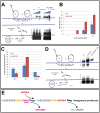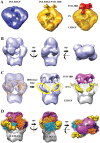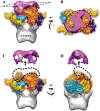Structural and functional role of INI1 and LEDGF in the HIV-1 preintegration complex
- PMID: 23593299
- PMCID: PMC3623958
- DOI: 10.1371/journal.pone.0060734
Structural and functional role of INI1 and LEDGF in the HIV-1 preintegration complex
Abstract
Integration of the HIV-1 cDNA into the human genome is catalyzed by the viral integrase (IN) protein. Several studies have shown the importance of cellular cofactors that interact with integrase and affect viral integration and infectivity. In this study, we produced a stable complex between HIV-1 integrase, viral U5 DNA, the cellular cofactor LEDGF/p75 and the integrase binding domain of INI1 (INI1-IBD), a subunit of the SWI/SNF chromatin remodeling factor. The stoichiometry of the IN/LEDGF/INI1-IBD/DNA complex components was found to be 4/2/2/2 by mass spectrometry and Fluorescence Correlation Spectroscopy. Functional assays showed that INI1-IBD inhibits the 3' processing reaction but does not interfere with specific viral DNA binding. Integration assays demonstrate that INI1-IBD decreases the amount of integration events but inhibits by-product formation such as donor/donor or linear full site integration molecules. Cryo-electron microscopy locates INI1-IBD within the cellular DNA binding site of the IN/LEDGF complex, constraining the highly flexible integrase in a stable conformation. Taken together, our results suggest that INI1 could stabilize the PIC in the host cell, by maintaining integrase in a stable constrained conformation which prevents non-specific interactions and auto integration on the route to its integration site within nucleosomes, while LEDGF organizes and stabilizes an active integrase tetramer suitable for specific vDNA integration. Moreover, our results provide the basis for a novel type of integrase inhibitor (conformational inhibitor) representing a potential new strategy for use in human therapy.
Conflict of interest statement
Figures







Similar articles
-
INI1/hSNF5-interaction defective HIV-1 IN mutants exhibit impaired particle morphology, reverse transcription and integration in vivo.Retrovirology. 2013 Jun 24;10:66. doi: 10.1186/1742-4690-10-66. Retrovirology. 2013. PMID: 23799881 Free PMC article.
-
Integrase interactor 1 (Ini1/hSNF5) is a repressor of basal human immunodeficiency virus type 1 promoter activity.J Gen Virol. 2009 Oct;90(Pt 10):2503-2512. doi: 10.1099/vir.0.013656-0. Epub 2009 Jun 10. J Gen Virol. 2009. PMID: 19515827
-
The integrase interactor 1 (INI1) proteins facilitate Tat-mediated human immunodeficiency virus type 1 transcription.Retrovirology. 2006 Aug 5;3:47. doi: 10.1186/1742-4690-3-47. Retrovirology. 2006. PMID: 16889668 Free PMC article.
-
Integrase interactor 1 in health and disease.Curr Protein Pept Sci. 2015;16(6):478-90. doi: 10.2174/1389203716666150316115156. Curr Protein Pept Sci. 2015. PMID: 25772157 Review.
-
Cellular co-factors of HIV-1 integration.Trends Biochem Sci. 2006 Feb;31(2):98-105. doi: 10.1016/j.tibs.2005.12.002. Epub 2006 Jan 5. Trends Biochem Sci. 2006. PMID: 16403635 Review.
Cited by
-
An Essential Role of INI1/hSNF5 Chromatin Remodeling Protein in HIV-1 Posttranscriptional Events and Gag/Gag-Pol Stability.J Virol. 2016 Oct 14;90(21):9889-9904. doi: 10.1128/JVI.00323-16. Print 2016 Nov 1. J Virol. 2016. PMID: 27558426 Free PMC article.
-
HIV-1 capsid and viral DNA integration.mBio. 2024 Jan 16;15(1):e0021222. doi: 10.1128/mbio.00212-22. Epub 2023 Dec 12. mBio. 2024. PMID: 38085100 Free PMC article. Review.
-
Transgenic expression of the human LEDGF/p75 gene relieves the species barrier against HIV-1 infection in mouse cells.Front Microbiol. 2013 Dec 17;4:377. doi: 10.3389/fmicb.2013.00377. eCollection 2013. Front Microbiol. 2013. PMID: 24381568 Free PMC article.
-
Repair of oxidative DNA base damage in the host genome influences the HIV integration site sequence preference.PLoS One. 2014 Jul 22;9(7):e103164. doi: 10.1371/journal.pone.0103164. eCollection 2014. PLoS One. 2014. PMID: 25051054 Free PMC article.
-
Impact of Chromatin on HIV Replication.Genes (Basel). 2015 Sep 30;6(4):957-76. doi: 10.3390/genes6040957. Genes (Basel). 2015. PMID: 26437430 Free PMC article. Review.
References
-
- Chiu TK, Davies DR (2004) Structure and function of HIV-1 integrase. CurrTopMedChem 4: 965–977. - PubMed
Publication types
MeSH terms
Substances
LinkOut - more resources
Full Text Sources
Other Literature Sources
Research Materials

